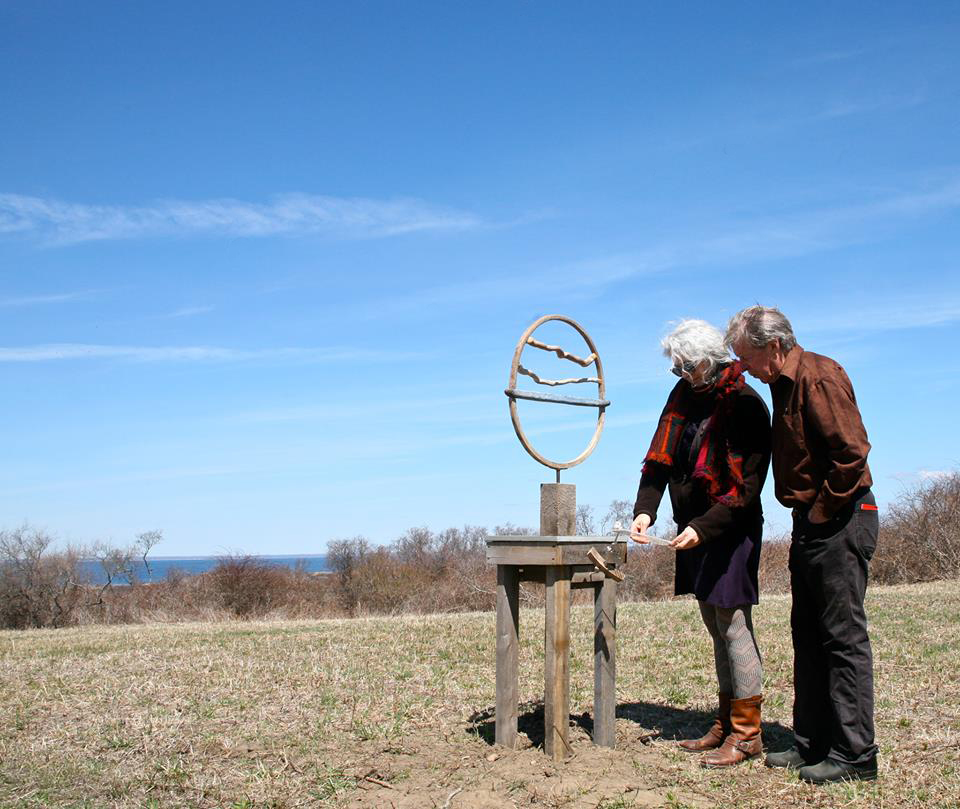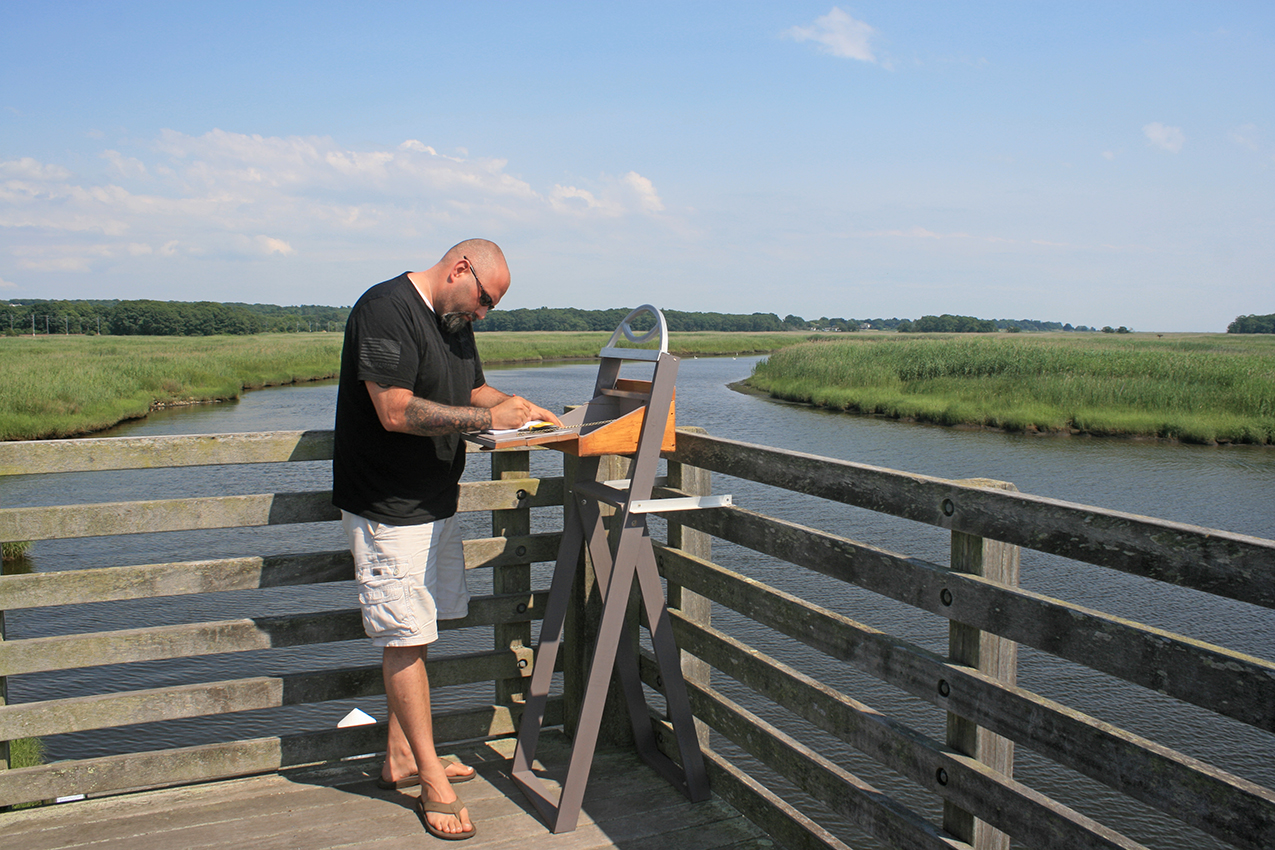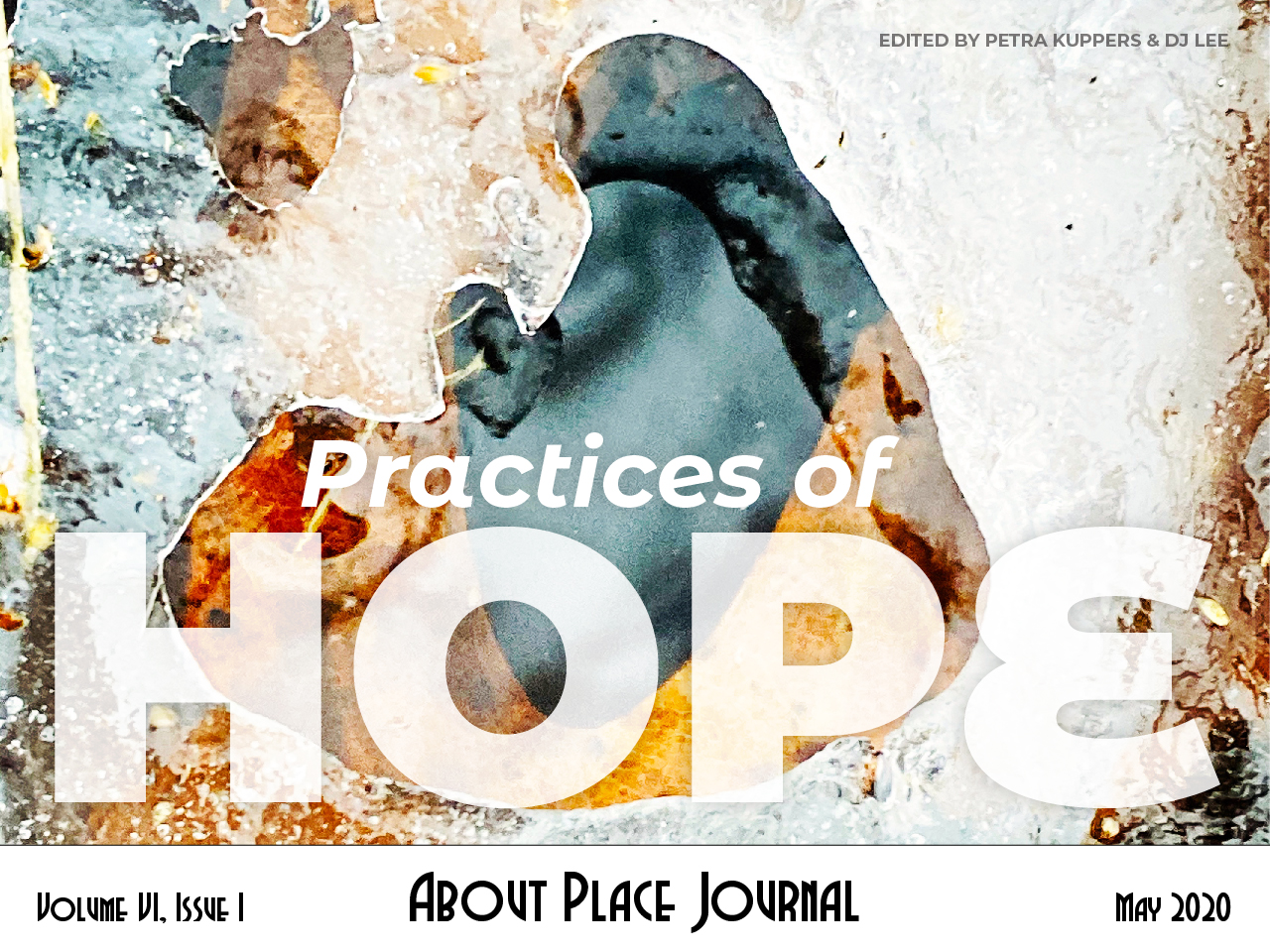The ice in the river outside my window groaned and squealed as it began to break up. I sat in my makeshift office tucked into a corner of the library of the Wood-Pawcatuck Watershed Association (WPWA) headquarters. I was the new Artist in Residence for the watershed, and their first. There wasn’t a great deal of office space in the building to spare, and when I say I was in the library, it wasn’t a great vaulted room but a modest bedroom full of bookcases. The headquarters was in a renovated cottage that cantilevered out over the Pawcatuck River in Southern Rhode Island. When the larger ice floes broke up in the river below, the entire wooden building shuddered.
As I gazed out my window I saw only black and white; it was March in New England. In a few weeks a new palette would begin to show itself and surprise us out of our frozen stupor. The noise of the ice reminded me of the great undercurrent of life coursing through all these trees and plants that appeared lifeless. This was my first time as an artist working for an environmental group and the organization had never worked with an artist before, so we were both navigating uncharted waters. I was there thanks to a grant, and my project would last for three months. The only request that Lori Urso, the director, had made was to use the arts as a way to connect local residents with their watershed. Lori and I had gotten to know each other well over the past year by working together on a community environmental forum that I had coordinated. I also lived in the watershed and canoed its waters so I jumped at the opportunity to explore it further. As a musician herself Lori knew the creative process; she was trusting me with the freedom to find my way. I was thankful for her leap of faith.
But what to do? My first two days I sat in the library randomly selecting from the shelves. I read through books on the freshwater fish that the area was famous for, Brook and Rainbow trout. I hadn’t realized how interconnected the status of the forest was with the health of the river. Forest clearing destroyed the ecology of the land, and pollution and toxic pesticides inevitably ended up in the rivers. I also skimmed through books on water quality testing in New England rivers, and looked more closely into their guides on the trees of Northern New England. It was all interconnected. Before this, my own understanding of a watershed had been vague. I had learned about them in high school biology, but then, “watershed” was just a description in a book, a fact I had to learn to pass a test. The teacher never made us walk the watershed we lived in in Connecticut.
Now I was living and working in this watershed. I was part of this ecology and the health of the watershed affected my well being. I now grasped the challenge I had. I had to illuminate what a watershed was, what it did, and why we needed to protect the land around it as well as its waters. One of my missions would be to find a way to get people out to discover their watershed.
On day three I stepped out after a long day of reading and taking notes in the office. As I walked toward the dam near the headquarters the cold air cut me like a knife. I felt small as if I were a lone figure in a Chinese ink drawing. The monochrome landscape of the groaning river and tall oak trees overwhelmed me. It made me think of a particular Chinese scroll I had studied in a college art history class. Later that evening after making dinner for the family and putting our children to bed I went over to our bookcase of art books and found the large grey volume I wanted, my well-worn History of Art by H.W. Janson. I turned to the section on Chinese art and there it was. The painting I was thinking of, entitled Poet on Mountaintop, created 1500. The artist/poet was Shen Zhou. There was the lone figure in the landscape, with one fine ink line the artist had defined the slump of the poet’s shoulders bent from reading and the loose robes he wore. On all sides, the mountain fell away from him into ravines. With just a few vivid brushstrokes we could identify the twisted trees and bushes that eked out life there. Juniper, Yew, Cedar, Pine, were all trees I saw around me in Northern New England. Where the ink ended, the white space suggested great space and distance. The open spaces in the painting were like the wilderness we would never fully understand but needed to preserve. Inscribed in the left corner in beautiful calligraphy was a poem by Shen Zhou; the translation read:
White clouds sash-like
wrap mountain waists,
The rock terrace flies in space
distant, a narrow path.
Leaning on a bramble staff
far and free I gaze,
To the warble of valley brook
I will reply, whistling.
The next day I brought in the copy of the painting and pinned it on the empty bulletin board above my desk. It was a talisman for my new role. But with the temperatures up in the 40s and hints of spring in the air I decided to take Shen Zhou’s poem to heart and start taking walks “to listen to the warble of the brook and follow distant narrow paths.” I took with me my journal and stopped to make notes during my walks; these are some of the excerpts from that journal.
March 17 – I hear and see no birds along the trails. The ice is pretty much gone but the air is still cold. The most abundant signs of wildlife activity are what I’m bending over to pick up—litter from homo sapiens—litter dots the trails. Bringing garbage bags next time!
March 18 – My focus has shifted from naturalist to sociologist as I look at the kind of garbage dumped out here. As I fill garbage bags I’m wondering how I can make people more thoughtful. How do I turn slobs into poets?
March 19 – The soundscape of the watershed is diversifying. Birds are coming back to the forest to nest. Identified: Sharp Shinned Hawk, Flicker. Looking up I also noticed birdhouses in the trails, in the backyards. These are thoughtful gestures in the landscape. More garbage than usual today, came across a dump of plastic toys and baby diapers plus the usual alcohol containers of all sizes and cigarette boxes. No litter from wildlife, just the occasional scats, pellets from coyote, and owls.
March 20 – Walk, walk, walk, pick, pick, pick, I’m looking down more than up because of my garbage duty but I think I finally have an idea. Why not take the concept of the birdhouse—and transform it into a “poetry box.” The poetry box would open to reveal a poem about the natural world. Each box would also house a journal for the public to add their responses. Once installed, this trail of boxes could lure the public out to get to know their watershed.
After my first week, the organization probably wondered if they had made all this effort to just hire someone to do litter pick-up. But on Friday I reported to work and sat down with Lori and told her I finally had an idea. She looked relieved. I took a deep breath and shared my thinking with her. “All of those bags of litter I’ve been collecting have actually been one of my inspirations, it’s made me wonder ‘how do we turn slobs into poets?’ I’ve seen a lot of the bird houses along the trails, so I thought why not transform the idea of a bird house into a poetry box? By just adding a hinged front door, each box can feature a poem about the natural world and include a journal for people to respond. And the boxes can be made by community members. I will make only one or two. And if I say poetry boxes are based on the idea of bird houses, no one will feel intimidated at the thought of making one. You don’t have to be an artist to make bird houses. We can also encourage that the poetry boxes to be decorated as artfully—and wild fully as they want.”
I also explained that the poetry boxes were really an excuse for many other things to happen. In order to introduce the project to the community we needed to explain what a watershed was and that meant addressing the connections between land and rivers, and telling people about what the watershed organization did. Lori really liked what she heard and said they had a 3D model of a watershed that they used for their environmental education. It could provide a real hands-on way of understanding a watershed. Students were given spray bottles, and they could see how the water they spray falls like rain on the three-dimensional topographical map made of plaster. They see how the water is filtered by the land before it reaches the low reaches of the river.
With the help of Denise, the director of education at WPWA, we scheduled talks in the local libraries and I called a local art school teacher who taught in several elementary schools to get them involved. After these talks we could sign up volunteers who would help us with the many elements of the project. We needed a committee to find sites for the boxes; we needed people who would make boxes; we needed a poetry committee to select poems if people needed suggestions; and we needed an installation committee. Also once the boxes went up we would need people to monitor them; these would be the “poetry wardens.” These various activities would allow people with different talents and interests to get involved. The project would also bring home the connections between art and nature.
I had done enough artist residencies in other settings to know that whatever I did with the community had to be made by them and not just me. That way they would call it theirs and feel both pride and stewardship. My first artist residencies had been tightly controlled mural projects for public schools; I’d design the mural and plan to do most of the painting myself, using students and volunteers to help paint in the details and backgrounds, often no more challenging that a giant colouring book. But I soon learned that more interesting results happened when everyone felt that they were co-creators. The murals then became a stage for discovering new talent. Over the years I began to allow more and more for the collective energy of the community to dictate what I did. In my public art projects, I designed for inclusion rather than carefully directing apprentices. My inspirations for these collaborative projects often came from folk art, traditions that arose out of the people’s collective imagination and mythology. The bird house certainly had a folk tradition behind it.
For the first project in Rhode Island a dozen boxes were installed along trails that took you through forests, to the edge of the river, and to the coastline. Once the boxes were up another wave of participation began. Families took walks to find them, students who had helped make boxes took their parents and siblings out to look for them, lovers left notes to each other in them, and thoughtful hikers jotted short poems. The journals which were just cheap memo pads filled up with poems and wildlife observations. During the three months the boxes were left up, each box had to have journals replaced three times. The watershed had become a destination, and walking was a way to understand this habitat. The public notebooks filled to the brim with comments indicating that the opportunity for walkers to stop, observe and write seemed to fill a needed void. We had given the public a chance to be poets—if only for a short time. The trails leading to the boxes also became less littered.

I had no idea that what I cobbled together in response to this very particular landscape and a river in only a few weeks would become a template that could be used almost anywhere. But the Poetry of the Wild was soon tested in a very different geography. I was invited to take it out to Colorado Springs, a city that had more parkland within its boundaries than all of Rhode Island as a state. There my sponsor was the Smokebrush Foundation, and they used the project to partner with schools, libraries and the University of Colorado at Colorado Springs. The Colorado project expanded to 24 boxes. This project also focused on the preservation of so many acres of parklands, something the citizens often took for granted. It also addressed how wildness was a source of wellness for all the inhabitants as well as a source of great creativity. All the poems in this project were written by a local poetry group whose poems were inspired by the local landscape. Again because of the many opportunities for engagement that project was extremely successful. They auctioned off the boxes at the end and had a poetry reading, plus they made a lovely little chapbook of the project.
A few years later it went further West to Tubac, Arizona; there it focused again on a watershed, the Santa Cruz River watershed. The history of this geography is very complicated because it is on the border with Mexico. The river attracts all kinds of birds, plus it is one of the routes that illegal migrants travel through—or did. After my initial talks to introduce the project, mentioning my initial inspiration of litter sparking the question, “how do you turn slobs into poets,” the community decided to do a volunteer river clean up. Two days of litter pick up were scheduled and two huge dumpsters of trash were hauled away. The massive clean-up got even more people talking about the project and interested in the watershed. Tubac’s installation became the largest and most far reaching—forty two extraordinary boxes were installed. Many of them commenting on the migrants that passed through, this area of desert and mountains—human and winged creatures.
Over the years the project has also been installed in urban settings such as St Louis, Missouri, and New London, Connecticut. The urban sites have allowed us to feature the voices of immigrant poets and get an insight of how they see their new homes. And diversity in the project has meant not only a diversity of cultures represented but also a wide range of ages. In Mystic, Connecticut we had the broadest diversity of poets participating; poets from age 8 to 80 years old, new poets, emerging poets, and published poets.

Over the past fifteen years I have witnessed how the design that provides meaningful participation has allowed each community to share and appreciate what is special about their places in a novel and simple way. In every situation the project has also helped forge new partnerships between organizations. Libraries have worked with environmental groups for the first time. Arts centers have had a reason to pair up with an environmental group in town or partner with schools in town. I also feel blessed to have had the opportunity to meet and work with the stewards, leaders, artists, and poets who enrich the places where they live. They have given me intimate and impassioned tours of the places they love and together we have mapped the soul of their communities. Poetry has allowed us to celebrate the meta story and the small wonders of their places. A quote from John Muir that I selected for one of the boxes for the first project in Rhode Island perhaps evokes best one of the project’s lasting effects. I went out for a walk and finally concluded to stay out till sundown, for going out, I found, was really going in.
More information about the Poetry of the Wild project at poetryofthewild.com.


